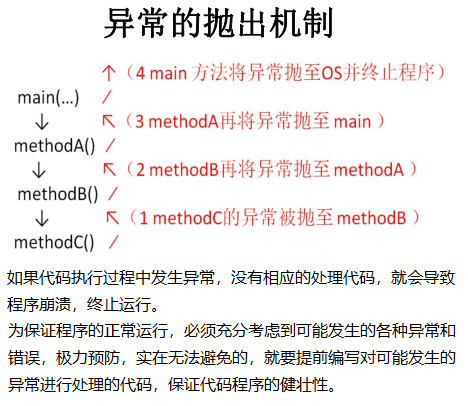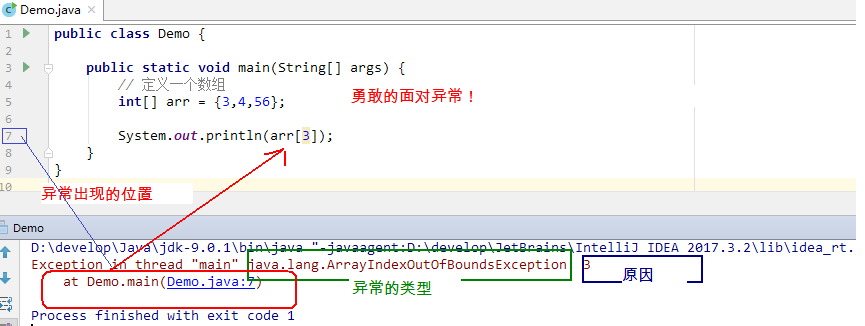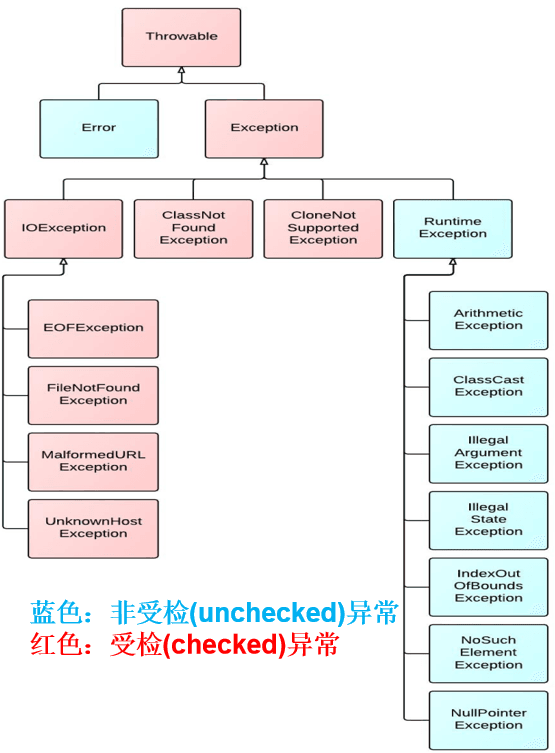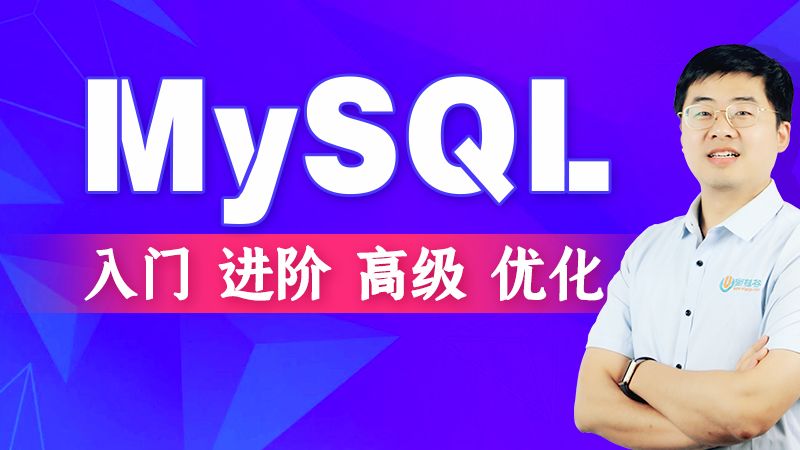一文搞懂Java异常
第8章 异常
本章学习目标
- 知道编译时异常(受检异常)与运行时异常(非受检异常)
- 掌握常见的几种异常或错误类型
- 掌握try-catch结构的语法格式和执行特点
- 掌握关键字finally的作用和特点
- 掌握关键字throw的作用
- 掌握关键字throws的作用
- 知道throw与throws的区别
- 了解Object类clone方法的重写
8.1 异常概述
8.1.1 认识Java的异常
什么是异常
在使用计算机语言进行项目开发的过程中,即使程序员把代码写得尽善尽美,在系统的运行过程中仍然会遇到一些问题,因为很多问题不是靠代码能够避免的,比如:客户输入数据的格式问题,读取文件是否存在,网络是否始终保持通畅等等。
异常 :指的是程序在执行过程中,出现的非正常的情况,如果不处理最终会导致JVM的非正常停止。
异常指的并不是语法错误,语法错了,编译不通过,不会产生字节码文件,根本不能运行.
异常也不是指逻辑代码错误而没有得到想要的结果,例如:求a与b的和,你写成了a-b
如何对待异常
程序员在编写程序时,就应该充分考虑到各种可能发生的异常和错误,极力预防和避免,实在无法避免的,要编写相应的代码进行异常的检测、异常消息的提示,以及异常的处理。
异常的抛出机制
Java中是如何表示不同的异常情况,又是如何让程序员得知,并处理异常的呢?
Java中把不同的异常用不同的类表示,一旦发生某种异常,就通过创建该异常类型的对象,并且抛出,然后程序员可以catch到这个异常对象,并处理,如果无法catch到这个异常对象,那么这个异常对象将会导致程序终止。
运行下面的程序,程序会产生一个数组索引越界异常ArrayIndexOfBoundsException。我们通过图解来解析下异常产生和抛出的过程。
工具类
public class ArrayTools { // 对给定的数组通过给定的角标获取元素。 public static int getElement(int[] arr, int index) { int element = arr[index]; return element; } }测试类
public class ExceptionDemo { public static void main(String[] args) { int[] arr = { 34, 12, 67 }; int num = ArrayTools.getElement(arr, 4); System.out.println("num=" + num); System.out.println("over"); } }上述程序执行过程图解:




8.1.2 Java异常体系
Throwable
`java.lang.Throwable` 类是Java语言中所有错误或异常的超类。
只有当对象是此类(或其子类之一)的实例时,才能通过Java 虚拟机或者Java的`throw` 语句抛出。类似地,只有此类或其子类之一才可以是 `catch` 子句中的参数类型。
Error和Exception
`Throwable`有两个直接子类:`java.lang.Error`与`java.lang.Exception`,平常所说的异常指`java.lang.Exception`。
Error:表示严重错误,一旦发生必须停下来查看问题并解决问题才能继续,无法仅仅通过try...catch解决的错误。(如果拿生病做比喻,就像是突发疾病,而且是危重症,必须立刻停下来治疗而不是靠短暂休息、吃药、打针、或小手术简单解决处理)
例如:StackOverflowError(栈内存溢出)和OutOfMemoryError(堆内存溢出,简称OOM)。
Exception:表示普通异常,其它因编程错误或偶然的外在因素导致的一般性问题,程序员可以通过代码的方式检测、提示和纠正,使程序继续运行,但是只要发生也是必须处理,否则程序也会挂掉。(这就好比普通感冒、阑尾炎、牙疼等,可以通过短暂休息、吃药、打针、或小手术简单解决,但是也不能搁置不处理,不然也会要人命)。
例如:空指针访问、试图读取不存在的文件、网络连接中断、数组下标越界等
无论是Error还是Exception,还有很多子类,异常的类型非常丰富。当代码运行出现异常时,特别是我们不熟悉的异常时,不要紧张,把异常的简单类名,拷贝到API中去查去认识它即可。


8.1.3 受检异常和非受检异常
我们平常说的异常就是指Exception,根据代码的编写编译阶段,编译器是否会警示当前代码可能发生xx异常,并督促程序员提前编写处理它的代码为依据,可以将异常分为:
- 编译时期异常(即checked异常、受检异常):在代码编译阶段,编译器就能明确警示当前代码可能发生(不是一定发生)xx异常,并督促程序员提前编写处理它的代码。如果程序员不听话,没有编写对应的异常处理代码,则编译器就会发威,直接判定编译失败,从而程序无法执行。通常,这类异常的发生不是由程序员的代码引起的,或者不是靠加简单判断就可以避免的,例如:FileNotFoundException(文件找不到异常)。
- 运行时期异常(即runtime异常、unchecked非受检异常):即在代码编译阶段,编译器完全不做任何检查,无论该异常是否会发生,编译器都不给出任何提示。只有等代码运行起来并确实发生了xx异常,它才能被发现。通常,这类异常是由程序员的代码编写不当引起的,只要稍加判断,或者细心检查就可以避免的。例如:ArrayIndexOutOfBoundsException数组下标越界异常,ClassCastException类型转换异常。

8.1.4 演示常见的错误和异常
Error
最常见的就是VirtualMachineError,它有两个经典的子类:StackOverflowError、OutOfMemoryError。
package com.atguigu.exception; import org.junit.Test; public class TestStackOverflowError { @Test public void test01() { //StackOverflowError digui(); } public void digui() { digui(); } }package com.atguigu.exception; import org.junit.Test; public class TestOutOfMemoryError { @Test public void test02() { //OutOfMemoryError //方式一: int[] arr = new int[Integer.MAX_VALUE]; } @Test public void test03() { //OutOfMemoryError //方式二: StringBuilder s = new StringBuilder(); while (true) { s.append("atguigu"); } } }非受检的运行时异常
package com.atguigu.exception; import org.junit.Test; import java.util.Scanner; public class TestRuntimeException { @Test public void test01() { //NullPointerException int[][] arr = new int[3][]; System.out.println(arr[0].length); } @Test public void test02() { //ClassCastException Object obj = 15; String str = (String) obj; } @Test public void test03() { //ArrayIndexOutOfBoundsException int[] arr = new int[5]; for (int i = 1; i <= 5; i++) { System.out.println(arr[i]); } } @Test public void test04() { //InputMismatchException Scanner input = new Scanner(System.in); System.out.print("请输入一个整数:");//输入非整数 int num = input.nextInt(); input.close(); } @Test public void test05() { int a = 1; int b = 0; //ArithmeticException System.out.println(a / b); } }受检的编译时异常
package com.atguigu.exception; import org.junit.Test; import java.io.FileInputStream; public class TestCheckedException { @Test public void test06() { Thread.sleep(1000);//休眠1秒,编译报错 } @Test public void test07() { FileInputStream fis = new FileInputStream("Java学习秘籍.txt");//编译报错 } }
8.2 异常的处理
Java异常处理的五个关键字:try、catch、finally、throw、throws
8.2.1 捕获异常:try…catch
当某段代码可能发生异常,不管这个异常是编译时异常(受检异常)还是运行时异常(非受检异常),我们都可以使用try块将它括起来,并在try块下面编写catch分支尝试捕获对应的异常对象。
try...catch语法格式:
try{
可能发生xx异常的代码
}catch(异常类型1 e){
处理异常的代码1
}catch(异常类型2 e){
处理异常的代码2
}
....try{
可能发生xx异常的代码
}catch(异常类型1 | 异常类型2 e){
处理异常的代码1
}catch(异常类型3 e){
处理异常的代码2
}
....- try{}中编写可能发生xx异常的业务逻辑代码。
- catch分支,分为两个部分,catch()中编写异常类型和异常参数名,{}中编写如果发生了这个异常,要做什么处理的代码。如果有多个catch分支,并且多个异常类型有父子类关系,必须保证小的子异常类型在上,大的父异常类型在下。
- 在catch分支中如何获取异常信息,Throwable类中定义了一些查看方法:
- `public String getMessage()`:获取异常的描述信息,原因(提示给用户的时候,就提示错误原因。
- `public void printStackTrace()`:打印异常的跟踪栈信息并输出到控制台。
包含了异常的类型,异常的原因,还包括异常出现的位置,在开发和调试阶段,都得使用printStackTrace。
- 执行流程
- 如果在程序运行时,try块中的代码没有发生异常,那么catch所有的分支都不执行。
- 如果在程序运行时,try块中的代码发生了异常,根据异常对象的类型,将从上到下选择第一个匹配的catch分支执行。此时try中发生异常的语句下面的代码将不执行,而整个try...catch之后的代码可以继续运行。
- 如果在程序运行时,try块中的代码发生了异常,但是所有catch分支都无法匹配(捕获)这个异常,那么JVM将会终止当前方法的执行,并把异常对象“抛”给调用者。如果调用者不处理,程序就挂了。
示例代码:
package com.atguigu.test;
import java.util.Scanner;
public class TestTryCatch1 {
public static void main(String[] args) {
Scanner input = new Scanner(System.in);
int m;
while (true) {
try {
System.out.print("请输入一个正整数:");
m = input.nextInt();
if (m < 0) {
System.out.println("输入有误," + m + "不是正整数!");
} else {
break;
}
} catch (InputMismatchException e) {
//String result = input.nextLine();
//System.out.println("输入有误," + result + "不是整数");
e.printStackTrace();
}
}
System.out.println("m = " + m);
}
}8.2.2 finally块
finally块
因为异常会引发程序跳转,从而会导致有些语句执行不到。而程序中有一些特定的代码无论异常是否发生,都需要执行。例如,IO流的关闭,数据库连接的断开等。这样的代码通常就会放到finally块中。
try{ }catch(...){ }finally{ 无论try中是否发生异常,也无论catch是否捕获异常,也不管try和catch中是否有return语句,都一定会执行 } 或 try{ }finally{ 无论try中是否发生异常,也不管try中是否有return语句,都一定会执行。 }注意:finally不能单独使用。
当只有在try或者catch中调用退出JVM的相关方法,例如System.exit(0),此时finally才不会执行,否则finally永远会执行。
示例代码:
package com.atguigu.keyword; import java.util.InputMismatchException; import java.util.Scanner; public class TestFinally { public static void main(String[] args) { Scanner input = new Scanner(System.in); try { System.out.print("请输入第一个整数:"); int a = input.nextInt(); System.out.print("请输入第二个整数:"); int b = input.nextInt(); int result = a / b; System.out.println(a + "/" + b + "=" + result); } catch (InputMismatchException e) { System.out.println("数字格式不正确,请输入两个整数"); } catch (ArithmeticException e) { System.out.println("第二个整数不能为0"); } finally { System.out.println("程序结束,释放资源"); input.close(); } } }
finally与return
finally中写了return语句,那么try和catch中的return语句就失效了,最终返回的是finally块中的
形式一:从try回来
public class TestReturn { public static void main(String[] args) { int result = test("12"); System.out.println(result); } public static int test(String str) { try { Integer.parseInt(str); return 1; } catch (NumberFormatException e) { return -1; } finally { System.out.println("test结束"); } } }形式二:从catch回来
public class TestReturn { public static void main(String[] args) { int result = test("a"); System.out.println(result); } public static int test(String str) { try { Integer.parseInt(str); return 1; } catch (NumberFormatException e) { return -1; } finally { System.out.println("test结束"); } } }形式三:从finally回来
public class TestReturn { public static void main(String[] args) { int result = test("a"); System.out.println(result); } public static int test(String str) { try { Integer.parseInt(str); return 1; } catch (NumberFormatException e) { return -1; } finally { System.out.println("test结束"); return 0; } } }
8.2.3 手工抛出异常对象:throw
- 异常对象生成的两种方式
- 由虚拟机自动生成:程序运行过程中,虚拟机检测到程序发生了问题,就会在后台自动创建一个对应异常类的实例对象并抛出——自动抛出。适用于核心类库中预定义的异常类型。
- 由开发人员手动创建:new 异常类型(【实参列表】);,如果创建好的异常对象不抛出对程序没有任何影响,和创建一个普通对象一样,但是一旦throw抛出,就会对程序运行产生影响了。适用于预定义类型和自定义异常。
throw异常对象的语法格式
throw new 异常类名(【参数】);throw语句抛出的异常对象,和JVM自动创建和抛出的异常对象一样,需要处理。如果没有被try..catch合理的处理,也会导致程序崩溃。
throw语句会导致程序执行流程被改变,throw语句是明确抛出一个异常对象,因此它下面的代码将不会执行,如果当前方法没有try...catch处理这个异常对象,throw语句就会代替return语句提前终止当前方法的执行,并返回一个异常对象给调用者。
package com.atguigu.throwdemo; public class TestThrow { public static void main(String[] args) { try { System.out.println(max(4, 2, 31, 1)); } catch (Exception e) { e.printStackTrace(); } try { System.out.println(max(4)); } catch (Exception e) { e.printStackTrace(); } try { System.out.println(max()); } catch (Exception e) { e.printStackTrace(); } } public static int max(int... nums) { if (nums == null || nums.length == 0) { throw new IllegalArgumentException("没有传入任何整数,无法获取最大值"); } int max = nums[0]; for (int i = 1; i < nums.length; i++) { if (nums[i] > max) { max = nums[i]; } } return max; } }
8.2.4 声明方法可能抛出的异常:throws
throws编译时异常
如果在编写方法体的代码时,某句代码可能发生某个编译时异常,不处理编译不通过,但是在当前方法体中可能不适合处理或无法给出合理的处理方式,就可以通过throws在方法签名中声明该方法可能会发生xx异常,需要调用者处理。
声明异常格式:
修饰符 返回值类型 方法名(参数) throws 异常类名1,异常类名2…{ }在throws后面可以写多个异常类型,用逗号隔开。
package com.atguigu.test; public class Triangle { private final double a; private final double b; private final double c; public Triangle(double a, double b, double c) throws Exception { if (a <= 0 || b <= 0 || c <= 0) { throw new Exception("三角形的边长必须是正数,不能为负数"); } if (a + b <= c || b + c <= a || a + c <= b) { throw new Exception(a + "," + b + "," + c + "不能构造三角形,三角形任意两边之后必须大于第三边"); } this.a = a; this.b = b; this.c = c; } public double getA() { return a; } public double getB() { return b; } public double getC() { return c; } @Override public String toString() { return "Triangle{" + "a=" + a + ", b=" + b + ", c=" + c + '}'; } }package com.atguigu.test; public class TestThrows { public static void main(String[] args) { try { Triangle t1 = new Triangle(2, 2, 3); System.out.println("三角形1创建成功:" + t1); } catch (Exception e) { System.err.println("三角形1创建失败"); e.printStackTrace(); } try { Triangle t2 = new Triangle(1, 1, 3); System.out.println("三角形2创建成功:" + t2); } catch (Exception e) { System.err.println("三角形2创建失败"); e.printStackTrace(); } } }throws运行时异常
当然,throws后面也可以写运行时异常类型,只是运行时异常类型,写或不写对于编译器和程序执行来说都没有任何区别。如果写了,唯一的区别就是调用者调用该方法后,使用try...catch结构时,IDEA可以获得更多的信息,需要添加什么catch分支。
package com.atguigu.test; public class TestThrowsRuntimeException { public static void main(String[] args) { try { System.out.println(divide(1, 2)); } catch (ArithmeticException e) { throw new RuntimeException(e); } } public static int divide(int a, int b) throws ArithmeticException { return a / b; } }
8.3 方法重写对于throws要求
方法重写对于throws要求
方法重写时,对于方法签名是有严格要求的:
- 方法名必须相同
- 形参列表必须相同
- 返回值类型
- 基本数据类型和void:必须相同
- 引用数据类型:<=
- 权限修饰符:>=,而且要求父类被重写方法在子类中是可见的
- 不能是static,final修饰的方法
- throws异常列表要求
- 如果父类被重写方法的方法签名后面没有 “throws 编译时异常类型”,那么重写方法时,方法签名后面也不能出现“throws 编译时异常类型”。
- 如果父类被重写方法的方法签名后面有 “throws 编译时异常类型”,那么重写方法时,throws的编译时异常类型必须<=被重写方法throws的编译时异常类型,或者不throws编译时异常。
- 方法重写,对于“throws 运行时异常类型”没有要求。
package com.atguigu.keyword; import java.io.IOException; public class TestOverride { } class Father { public void method() throws Exception { System.out.println("Father.method"); } } class Son extends Father { @Override public void method() throws IOException, ClassCastException { System.out.println("Son.method"); } }Object的clone方法和java.lang.Cloneable接口
在java.lang.Object类中有一个方法:
protected Object clone() throws CloneNotSupportedException所有类型都可以重写这个方法,它是获取一个对象的克隆体对象用的,就是造一个和当前对象各种属性值一模一样的对象。当然地址肯定不同。
我们在重写这个方法后时,调用super.clone(),发现报异常CloneNotSupportedException,因为我们没有实现java.lang.Cloneable接口。
class Teacher implements Cloneable { private int id; private String name; public Teacher(int id, String name) { super(); this.id = id; this.name = name; } public Teacher() { super(); } public int getId() { return id; } public void setId(int id) { this.id = id; } public String getName() { return name; } public void setName(String name) { this.name = name; } @Override public String toString() { return "Teacher [id=" + id + ", name=" + name + "]"; } @Override public Teacher clone() throws CloneNotSupportedException { return (Teacher) super.clone(); } }public class TestClonable { public static void main(String[] args) throws CloneNotSupportedException { Teacher src = new Teacher(1, "柴老师"); Teacher clone = src.clone(); System.out.println(clone); System.out.println(src); System.out.println(src == clone); } }


